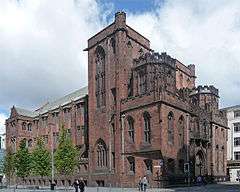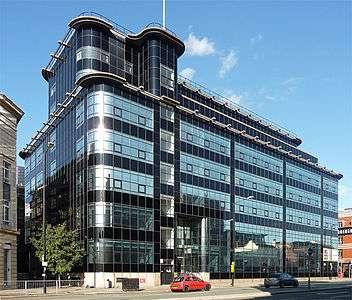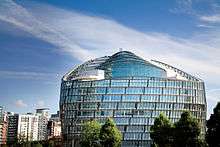Palace Theatre, Manchester
 | |
| Address |
Oxford Street Manchester England |
|---|---|
| Owner | Ambassador Theatre Group |
| Designation | Grade II |
| Type | Theatre |
| Capacity | 1,955 (seated) |
| Construction | |
| Opened | 18 May 1891 |
| Renovated | 1913 (interior) by Bertie Crewe |
| Years active | 1891–present |
| Architect | Alfred Darbyshire |
| Website | |
| Palace Theatre Manchester website at Ambassador Theatre Group | |
The Palace Theatre, Manchester, is one of the main theatres in Manchester, England. It is situated on Oxford Street, on the north-east corner of the intersection with Whitworth Street. The Palace and its sister theatre the Opera House on Quay Street are operated by the same parent company, Ambassador Theatre Group. The original capacity of 3,675 has been reduced to its current 1,955.[1]
History
The theatre, originally known as the Grand Old Lady of Oxford Street, opened on 18 May 1891, having been designed by the architect Alfred Darbyshire at a cost of £40,500. The interior of the theatre was renovated under by Bertie Crewe in 1913, the renovation took seven months and the theatre reopened with a reduced seating capacity of 2,600.[2]
In September 1940 the theatre took a direct hit from a German bomb during the Manchester Blitz.[3]
In the 1970s audience numbers declined, as they did in many live venues, and it was threatened with closure. The Arts Council supported it in the 1980s, and after major internal refurbishment and an enlarged stage facility, it was run by a charitable trust, Norwest Holdings.
It is now one of the best equipped and popular theatres outside London. In its repertoire it hosts major touring musicals often with major celebrities and performances of opera and ballet along with various other comedy acts and one night concerts.
Royal Opera House, Manchester
In 2008 the Royal Opera House and Manchester City Council began planning stages a new development known as Royal Opera House, Manchester. The proposal would have seen the Palace Theatre refurbished, to create a theatre capable of staging productions by both the Royal Ballet and Royal Opera. It was intended that the Royal Opera House would take residence of the theatre for an annual 18 week season, staging 16 performances by the Royal Opera, 28 performances by the Royal Ballet and other small-scale productions.[4][5] A year later The Lowry sent an open letter to the then Secretary of State for Culture, Olympics, Media and Sport, Ben Bradshaw, Arts Council England, Manchester City Council and the ROH, calling for the scheme, in its current form, to be scrapped.[6] In 2010 it was announced that the project was being shelved as part of larger arts-funding cuts.[7][8]
Productions
The opening presentation, to a capacity audience, was the ballet Cleopatra; however its initial presentations failed to gain popular support and for several years it struggled to make a profit. Only when it broadened its scope to include more popular performers was it a resounding success. During the early part of the 20th century it came into its own, with artists such as Danny Kaye, Gracie Fields, Charles Laughton, Judy Garland, Noël Coward and Laurel and Hardy making appearances.
Continuing a long tradition of tour openings in Manchester, the hit Broadway and West End musical The Producers opened at the theatre in February 2007 for a run until May when it continued on tour around the UK. Peter Kay starred as Roger Debris for the Manchester dates.
Other notable shows to have played successful seasons at the Palace Theatre include, amongst others, the regional premiere of Les Misérables which ran for 13 months from 1992–93, regional premiere of Miss Saigon in 2001, Chitty Chitty Bang Bang in 2006 and Mamma Mia! over the 2006/07 Christmas season. Broadway musical The Wedding Singer had its UK premiere at the theatre in 2008 and in December 2008 to March 2009 the theatre hosted a season of the UK tour of Mary Poppins, one of only six theatres in the country to accommodate the tour, both events further cementing the theatre's reputation as the flagship venue of the North of England. In July 2009, during the Manchester International Festival, the theatre, in association with Opera North, staged the world première of Rufus Wainwright's opera Prima Donna.
See also
- Opera House
- Live Nation deal – Ambassador Theatre Group's acquisition of venues previously owned by Live Nation UK
References
- ↑ "Palace Theatre Manchester: Venue Hire". atgtickets.com. Ambassador Theatre Group. Retrieved 24 November 2012.
- ↑ "Palace Theatre Manchester: Overview". atgtickets.com. Ambassador Theatre Group. Retrieved 3 August 2016.
- ↑ "Manchester Blitz". iwm.org.uk. Imperial War Museum. Archived from the original on 28 September 2011. Retrieved 2 April 2016.
- ↑ Higgins, Charlotte (28 October 2008). "Disharmony over Royal Opera's plan to go north". The Guardian. Guardian Media Group.
- ↑ Staff writer (31 October 2008). "Northern opera proposal evaluated". BBC News. BBC.
- ↑ Brown, Mark (25 June 2009). "Threat to plan for Royal Opera House in the north". The Guardian. Guardian Media Group.
- ↑ Staff writer (3 November 2010). "ROH shelves its plans to move north". The Stage. The Stage Media Company Ltd. Alternative link.
- ↑ Sharp, Rob (27 October 2010). "Royal Opera House shelves move north". The Independent. Independent Print Ltd.
External links
| Wikimedia Commons has media related to Palace Theatre, Manchester. |
Coordinates: 53°28′30″N 2°14′27″W / 53.47500°N 2.24083°W




